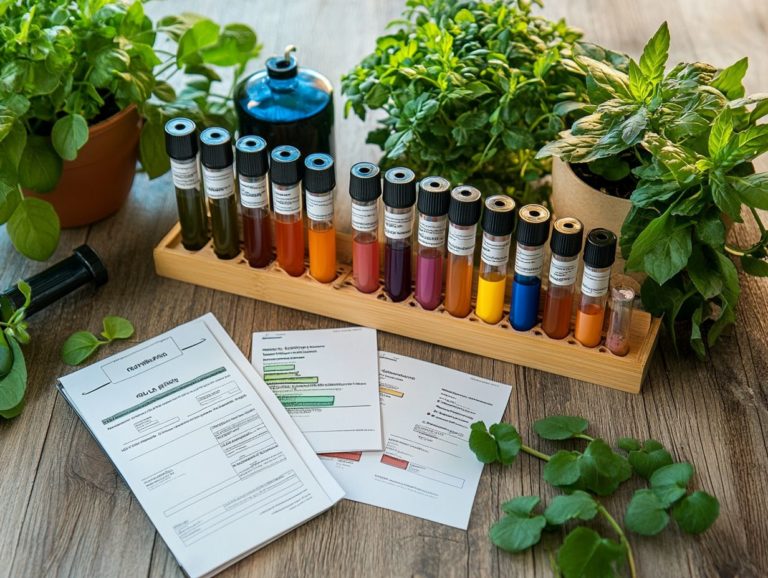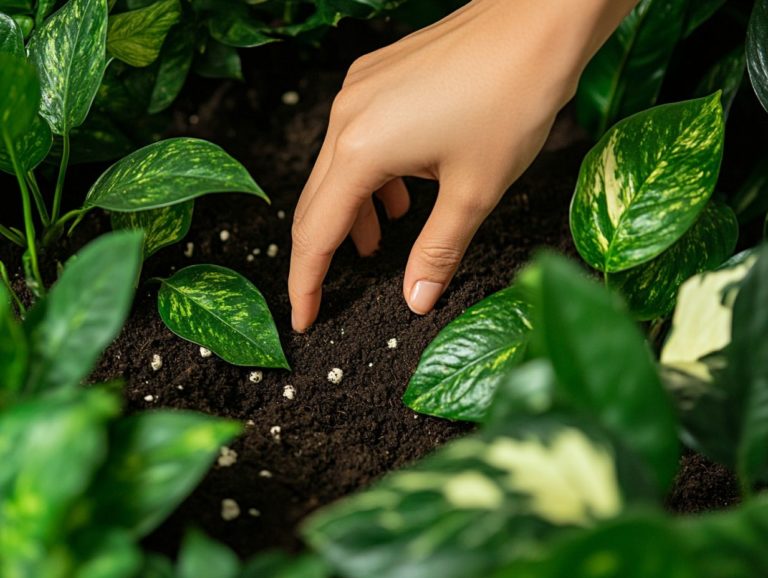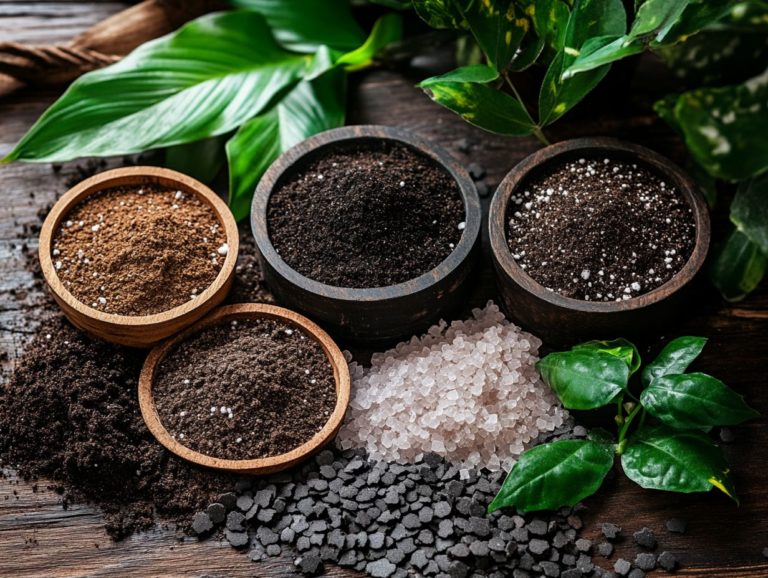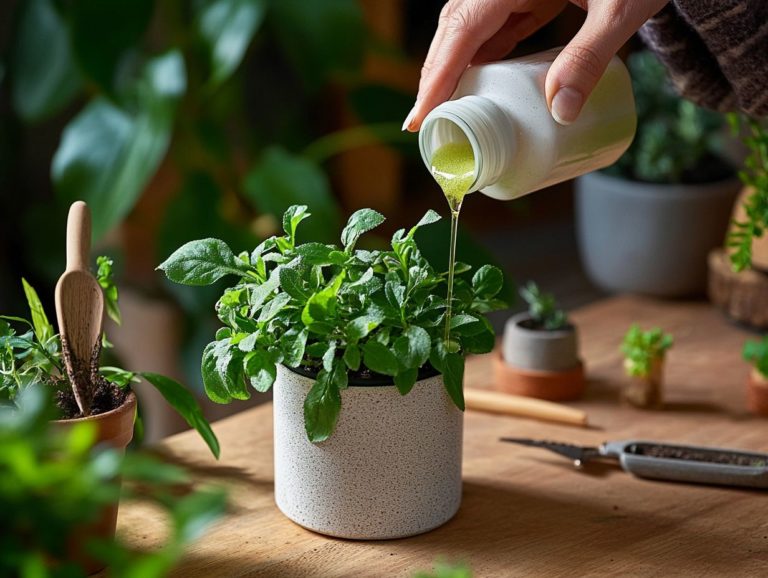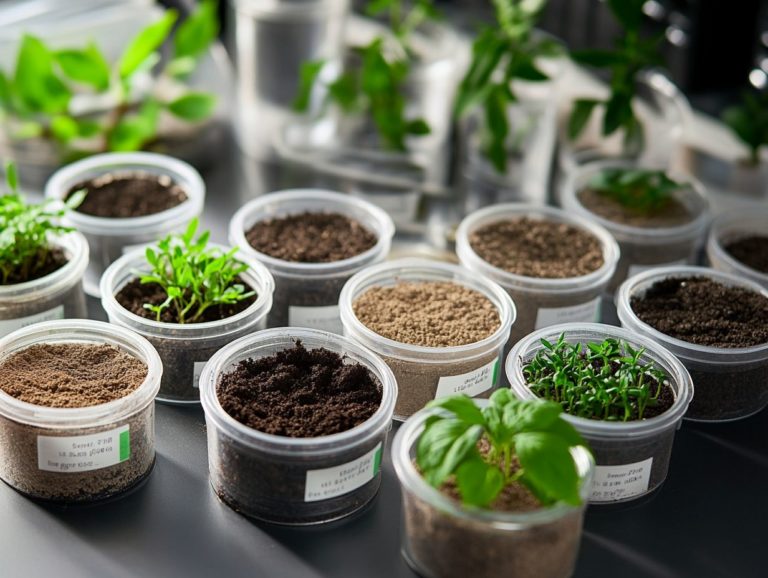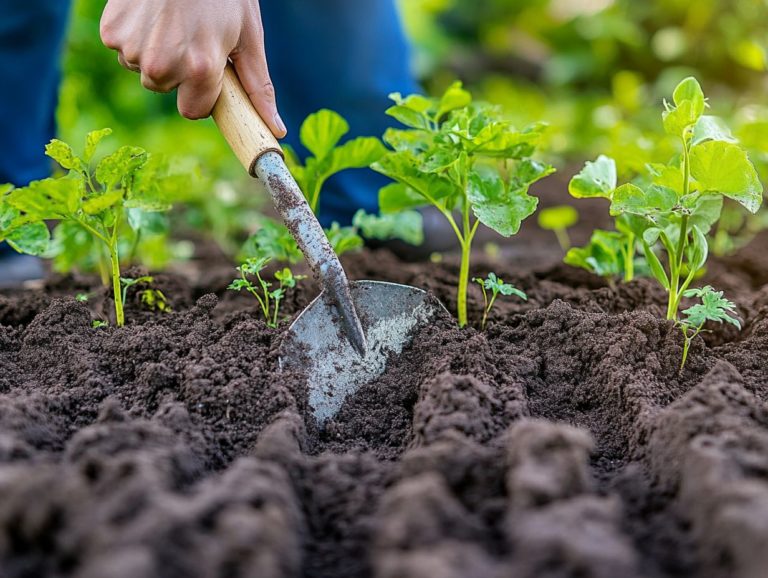Signs of Nutrient Deficiency in Indoor Plants
Indoor plants can transform any space into a lush sanctuary. However, if your plants start showing signs of distress, it s usually a cry for help due to nutrient deficiencies.
This guide helps you identify those common visual signs and symptoms of nutrient deficiencies. It provides straightforward steps for testing your soil and plant tissue. Additionally, it delves into effective treatment strategies, such as adjusting soil pH and utilizing fertilizers. You ll also find valuable tips for prevention through proper care and the right soil choices.
By grasping these key concepts, you can ensure your indoor plants not only survive but thrive, maintaining their vibrant beauty for all to enjoy!
Contents
- Key Takeaways:
- Identifying Nutrient Deficiency in Indoor Plants
- Treating Nutrient Deficiency in Indoor Plants
- Preventing Nutrient Deficiency in Indoor Plants
- Common Causes and Effects
- Frequently Asked Questions
- What are some common signs of nutrient deficiency in indoor plants?
- How can I tell which nutrient my indoor plant is deficient in?
- What happens if I don’t address a nutrient deficiency in my indoor plant?
- What are some ways to address a nutrient deficiency in my indoor plant?
- How can I prevent nutrient deficiencies in my indoor plants?
- Can over-fertilization also lead to nutrient deficiencies in indoor plants?
Key Takeaways:
- Look out for signs of nutrient deficiency, such as yellowing leaves or stunted growth.
- Test soil and plant tissue to identify specific nutrient needs.
- Maintain proper care by choosing the right soil and fertilizers.
Identifying Nutrient Deficiency in Indoor Plants
Identifying nutrient deficiencies in your indoor plants is essential for achieving optimal health and growth. Deficiencies in key nutrients like nitrogen, potassium, magnesium, and phosphorus can manifest in various ways. Look closely; poor growth, yellowing leaves, and stunted development can indicate a problem.
By recognizing these signs of nutrient deficiency early on, you can take proactive measures to maintain the well-being of your indoor plants. This ensures they flourish beautifully in their environment.
Visual Signs and Symptoms
Visual signs and symptoms of nutrient deficiency can reveal themselves in various ways. You might notice chlorosis, a condition where leaves turn yellow due to lack of nutrients, as well as leaf yellowing and stunted growth. Each points to specific deficiencies in nitrogen, potassium, or magnesium.
If you see curling or crispy leaf edges, it’s likely a signal of potassium deficiency, an essential nutrient for overall plant health and moisture regulation. Additionally, if your plant is showing signs of overwatering, such as dropping leaves or having short internodes, it typically indicates a magnesium deficiency, critical for photosynthesis and nutrient transport.
Conversely, if your plants boast excessively dark green foliage, you could be dealing with nitrogen overload. Adding to the complexity, brown spots may suggest a calcium deficiency.
By remaining vigilant to these symptoms, you can make informed decisions that will enhance the vitality and resilience of your indoor plant collection.
Testing Soil and Plant Tissue
Testing soil and plant tissue is crucial for diagnosing nutrient deficiencies. It provides valuable insights into the chemical elements at play and their effects on plant health and growth.
These evaluations utilize a range of methods, including soil sampling, pH testing, and tissue analysis. They create a comprehensive overview of soil fertility and plant vitality. Soil testing can uncover essential information about nutrient levels such as nitrogen, phosphorus, and potassium while tissue testing reveals the actual nutrient content within your plants. By interpreting these results, you can pinpoint specific deficiencies and adjust your fertilization strategies accordingly.
This proactive approach boosts your yield potential and supports sustainable farming practices, ensuring your crops remain robust and resilient against environmental challenges.
Treating Nutrient Deficiency in Indoor Plants
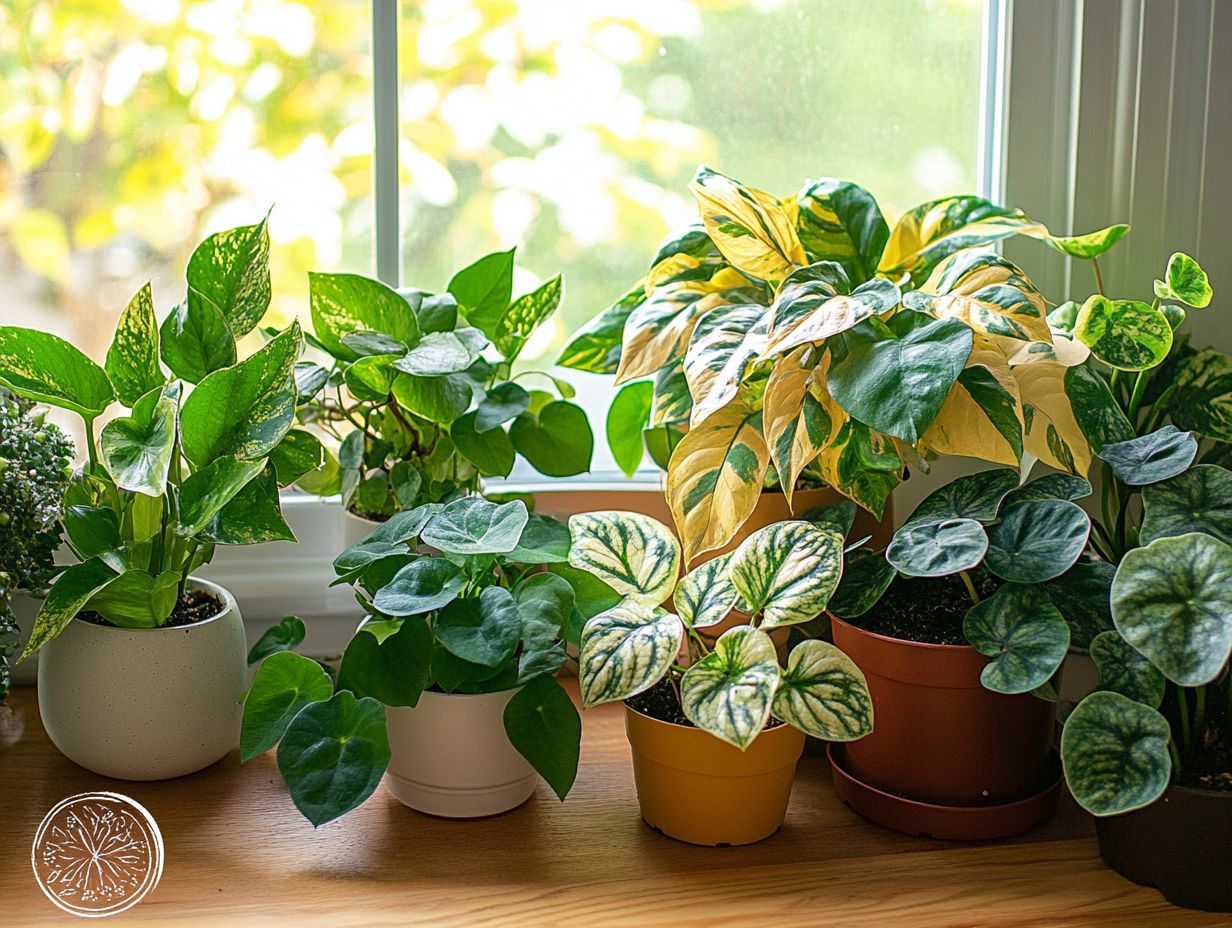
Addressing nutrient deficiency in your indoor plants requires a thoughtful strategy. You’ll want to adjust the soil pH, enhance nutrient levels, and apply the appropriate fertilizers to correct any deficiencies, especially those linked to magnesium, potassium, or phosphorus.
This meticulous approach ensures your plants receive the nourishment they need to thrive.
Adjusting Soil pH and Nutrient Levels
Adjusting soil pH and nutrient levels is crucial for addressing nutrient deficiencies in your indoor plants. The right pH (a measure of how acidic or alkaline the soil is) ensures that nutrients are available for optimal absorption, particularly for potassium and magnesium.
To navigate this process successfully, begin by measuring the current pH levels with a reliable pH meter or soil test kit. This will give you a baseline understanding of your soil’s conditions. If you find that adjustments are necessary, you can add lime to raise the pH and create a more alkaline environment, or use sulfur to lower it, making the soil more acidic.
Incorporating organic matter, such as compost, will enhance nutrient availability and help balance any deficiencies. Regularly monitoring pH and nutrient levels promotes plant health and fosters vibrant, robust growth, transforming your indoor garden into a lush sanctuary.
Supplementing with Fertilizers
Supplementing your indoor plants with fertilizers is a powerful strategy to correct nutrient deficiencies. Fertilizers provide essential nutrients like potassium, magnesium, and phosphorus, promoting robust growth and vibrant foliage.
Both organic and inorganic fertilizers play unique roles in plant care. Organic options, such as compost and manure, enrich your soil with beneficial microorganisms, enhancing nutrient availability and supporting overall soil health. In contrast, inorganic fertilizers deliver immediate nutrient absorption, containing precise concentrations of specific elements designed to address deficiencies directly.
Applying these fertilizers correctly is vital. Slow-release formulas can be incorporated into the soil, while liquid types should be diluted for effective foliar feeding. By understanding these methods, you can maximize the benefits of fertilization, ensuring your indoor plants thrive and recover efficiently.
Preventing Nutrient Deficiency in Indoor Plants
To prevent nutrient deficiency in your indoor plants, you must engage in diligent care. This involves proper maintenance practices, regular soil preparation, and making thoughtful selections of soil and fertilizers tailored to meet the specific needs of your plants.
Proper Plant Care and Maintenance

Proper plant care and maintenance are crucial for preventing nutrient deficiencies. This ensures your indoor plants receive the right balance of nutrients, adequate water, and organic matter to thrive.
It s not just about watering and fertilizing; understanding the specific light requirements for each type of plant is equally vital. Different species flourish in varying light conditions, ranging from bright, indirect sunlight to low-light environments.
Regular pruning is another key aspect. It promotes healthy growth by removing dead or overcrowded foliage, allowing for better airflow and light penetration.
Adopting this care approach guarantees your plants won’t just survive; they’ll thrive spectacularly, creating vibrant, healthy spaces that enhance both well-being and aesthetic appeal. By integrating these core principles, you can cultivate an environment where your greenery thrives beautifully.
Choosing the Right Soil and Fertilizers
Choosing the right soil and fertilizers is essential for preventing nutrient deficiencies in your indoor plants. Quality soil enriched with organic matter promotes healthy growth and optimal nutrient absorption.
A well-balanced mix should typically contain components like peat moss, perlite, and compost. Each of these offers unique benefits that are crucial for aeration, moisture retention, and nutrient availability. When selecting fertilizers, it s important to consider water-soluble options that effectively deliver nutrients while also addressing the specific needs of the plants you re cultivating.
Regularly checking pH levels is another key factor in ensuring your indoor plants thrive, as certain species favor more acidic or alkaline conditions. Additionally, it’s important to be aware of the signs of root rot to maintain their health. By understanding these characteristics and carefully choosing the right soil and fertilizer blends, you can significantly enhance the vitality and overall health of your indoor green spaces.
Common Causes and Effects
Nutrient deficiencies in your indoor plants can often stem from inadequate agricultural practices, leading to sluggish growth and a variety of troubling symptoms, such as chlorosis and general plant weakness.
Several factors contribute to these challenges. For instance, poor soil quality lacking essential minerals and nutrients is a significant culprit. Improper watering techniques, such as giving too much or too little water, can damage soil health. This prevents your plants from absorbing the nutrients they desperately need. To better understand how to identify when your plants are struggling, check out the top 5 signs of indoor plant distress.
As a result, you may see signs of nutrient deficiencies show up as stunted growth, yellowing leaves, and reduced productivity. This can seriously harm your plants. Get to know these issues to help your plants flourish!
Frequently Asked Questions
What are some common signs of nutrient deficiency in indoor plants?

Some common signs include yellowing or browning of leaves, stunted growth, and wilting or drooping of leaves.
How can I tell which nutrient my indoor plant is deficient in?
Different nutrients result in different visual symptoms. For example, nitrogen deficiency causes yellowing of older leaves, while potassium deficiency causes yellowing of leaf margins.
What happens if I don’t address a nutrient deficiency in my indoor plant?
If left untreated, nutrient deficiencies can lead to poor growth, weak stems, and increased susceptibility to pests and diseases.
What are some ways to address a nutrient deficiency in my indoor plant?
You can address a deficiency by fertilizing with a balanced fertilizer, adjusting the pH of the soil, or adding specific nutrients through foliar sprays (liquid fertilizer applied to leaves) or root drenches.
How can I prevent nutrient deficiencies in my indoor plants?
Regularly fertilizing with a balanced fertilizer and monitoring the pH of the soil can help prevent nutrient deficiencies. It is also important to provide adequate water and proper lighting for your plants.
Can over-fertilization also lead to nutrient deficiencies in indoor plants?
Yes, over-fertilization can cause imbalances in nutrient levels and hinder the plant’s ability to absorb necessary nutrients. It is important to follow the recommended dosage when fertilizing and to avoid over-fertilizing.

